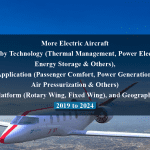OVERVIEW
The Aerospace and Defence Market is currently valued at USD 750 billion in 2024 and will be growing at a CAGR of 8.2% over the forecast period to reach an estimated USD 1388 billion in revenue in 2029. The aerospace and defense market encompasses a wide array of industries dedicated to the development, production, and maintenance of aircraft, spacecraft, missiles, and defense systems. It is a cornerstone of national security and technological advancement, serving both civilian and military needs worldwide. Key players range from established aerospace giants to innovative startups, all engaged in advancing the boundaries of aviation, space exploration, and defense capabilities. This dynamic market is characterized by intense competition, rapidly evolving technologies, stringent regulatory standards, and significant investments in research and development. With increasing globalization and geopolitical tensions, the aerospace and defense sector plays a critical role in shaping the future of transportation, communication, and security on a global scale.
Technological innovation stands at the forefront, continuously pushing boundaries in aircraft design, propulsion systems, and defense capabilities. Demand for commercial air travel remains robust, fueled by global economic growth and increasing passenger numbers. Moreover, the burgeoning space exploration sector, driven by both governmental agencies and private companies, presents new opportunities and challenges. Geopolitical tensions and security threats drive defense spending, leading to the development of advanced military technologies and systems. Additionally, environmental concerns and regulatory mandates are spurring the industry towards more sustainable practices and fuel-efficient aircraft designs. These drivers collectively shape the trajectory of the aerospace and defense market, influencing investment decisions, research priorities, and strategic partnerships within the industry.
Market Dynamics
Drivers:
Technological innovation stands at the forefront, continuously pushing boundaries in aircraft design, propulsion systems, and defense capabilities. Demand for commercial air travel remains robust, fueled by global economic growth and increasing passenger numbers. Moreover, the burgeoning space exploration sector, driven by both governmental agencies and private companies, presents new opportunities and challenges. Geopolitical tensions and security threats drive defense spending, leading to the development of advanced military technologies and systems. Additionally, environmental concerns and regulatory mandates are spurring the industry towards more sustainable practices and fuel-efficient aircraft designs. These drivers collectively shape the trajectory of the aerospace and defense market, influencing investment decisions, research priorities, and strategic partnerships within the industry.
Key Offerings:
In the aerospace and defense market, key offerings span a diverse range of products and services tailored to meet the complex needs of both civilian and military sectors. Aircraft manufacturing remains a cornerstone, with companies producing commercial airliners, military jets, helicopters, and unmanned aerial vehicles (UAVs). Alongside aircraft, propulsion systems, avionics, and aerospace components play crucial roles in enhancing performance and safety. Spacecraft development, including satellites, launch vehicles, and space exploration technologies, represents another significant offering, driven by growing interest in satellite communications, Earth observation, and deep space exploration. Defense systems encompass a wide array of products, including missile defense systems, radar technologies, cyber security solutions, and military vehicles. Maintenance, repair, and overhaul (MRO) services are also vital, ensuring the reliability and longevity of aerospace and defense assets throughout their operational lifespan.
Restraints :
The aerospace and defense industry faces several restraints that impact its growth and operations. One significant challenge is the high cost of research, development, and manufacturing associated with aerospace and defense technologies. This cost-intensive nature restricts the entry of new players and puts pressure on established companies to maintain competitiveness. Additionally, regulatory hurdles and compliance requirements add complexity and increase time-to-market for new products and technologies. Geopolitical uncertainties, trade disputes, and government budget constraints also pose challenges, impacting defense spending and affecting market dynamics. Moreover, the industry’s reliance on global supply chains makes it vulnerable to disruptions caused by events such as natural disasters, geopolitical tensions, and pandemics, as evidenced by recent supply chain disruptions during the COVID-19 pandemic. These restraints necessitate strategic planning, risk mitigation strategies, and innovative approaches to address challenges and sustain growth in the aerospace and defense sector.
Regional Information:
• In North America, particularly the United States, the aerospace and defense industry is a powerhouse, characterized by a robust ecosystem of companies, research institutions, and government agencies. Major aerospace players such as Boeing and Lockheed Martin dominate the market, supported by a strong network of suppliers and subcontractors. The U.S. government’s significant defense budget fuels innovation and drives demand for cutting-edge military technologies, making it a key market for defense contractors.
• In Europe, countries like France, the United Kingdom, and Germany boast thriving aerospace sectors, with Airbus leading the way in commercial aircraft manufacturing. European defense spending, while substantial, is spread across multiple nations, leading to collaboration and joint development programs such as the Eurofighter Typhoon.
• Asia-Pacific, led by emerging economies like China and India, is witnessing rapid growth in both civil aviation and defense capabilities. China’s ambitious aerospace initiatives, including its rapidly expanding commercial aircraft industry and space exploration programs, are reshaping the regional landscape. Meanwhile, India’s focus on indigenous defense production and space exploration underscores its strategic importance in the sector.
Recent Developments:
November 2023: The US Air Force signed a contract worth USD 2.3 billion with The Boeing Company for 15 KC-46A Pegasus refueling tankers. This would bring the total number of KC-46s Boeing has on contract to build for the United States and its allies to 153. The Air Force plans to buy 179 KC-46s.
November 2023: The US awarded a contract worth USD 176 million to the Lockheed Martin Corporation that primarily focuses on exercising options for producing 61 Lot 8 Long Range Anti-Ship Missiles (LRASM) with containers and initial spares.
Key Market Players:
Boeing, Airbus, Lockheed Martin, Northrop Grumman, Raytheon Technologies, BAE Systems, General Dynamics, Safran, Thales Group, and Leonardo S.p.A.
– The Aerospace and Defence Market is expected to reach an estimated value of USD 1388 billion in revenue by 2029.
2) What is the estimated CAGR of the Aerospace and Defence Market over the 2024 to 2029 forecast period?
– The CAGR is estimated to be 8.2% for the Aerospace and Defence Market over the 2024 to 2029.
3) Who are the key players in the Aerospace and Defence Market?
– Boeing, Airbus, Lockheed Martin, Northrop Grumman, Raytheon Technologies, BAE Systems, General Dynamics, Safran, Thales Group, and Leonardo S.p.A.
4) What are the drivers for the Aerospace and Defence Market?
– Technological innovation drives aircraft design, propulsion systems, and defense capabilities. Global economic growth, space exploration, geopolitical tensions, and environmental concerns shape the aerospace and defense market. Investment decisions, research priorities, and strategic partnerships are influenced by these drivers.
5) What are the restraints and challenges in the Aerospace and Defence Market?
– The aerospace and defense industry faces challenges due to high costs, regulatory hurdles, geopolitical uncertainties, trade disputes, and global supply chain disruptions. These restraints limit entry of new players, pressure established companies to maintain competitiveness, and make the sector vulnerable to events like natural disasters and pandemics. Strategic planning and innovative approaches are needed to sustain growth.
6) What are the key applications and offerings of the Aerospace and Defence Market?
– The aerospace and defense market offers a variety of products and services for both civilian and military sectors. Key offerings include aircraft manufacturing, spacecraft development, defense systems, missile defense systems, radar technologies, cyber security solutions, and maintenance, repair, and overhaul services. These offerings ensure the reliability and longevity of assets.
7) Which region is expected to drive the market for the forecast period?
– North America is expected to have the highest market growth from 2024 to 2029
Why Choose Us?
Insights into Market Trends: Global Market Studies reports provide valuable insights into market trends, including market size, segmentation, growth drivers, and market dynamics. This information helps clients make strategic decisions, such as product development, market positioning, and marketing strategies.
Competitor Analysis: Our reports provide detailed information about competitors, including their market share, product offerings, pricing, and competitive strategies. This data can be used to inform competitive strategies and to identify opportunities for growth and expansion.
Industry Forecasts: Our reports provide industry forecasts, which will inform your business strategies, such as investment decisions, production planning, and workforce planning. These forecasts can help you to prepare for future trends and to take advantage of growth opportunities.
Access to Industry Experts: Our solutions include contributions from industry experts, including analysts, consultants, and subject matter experts. This access to expert insights can be valuable for you to understand the market.
Time and Cost Savings: Our team at Global Market Studies can save you time and reduce the cost of conducting market research by providing comprehensive and up-to-date information in a single report, avoiding the need for additional market research efforts.












